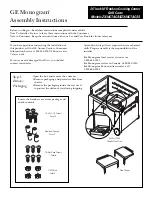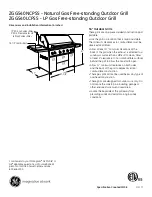
13
Fig� 28
Fig� 29
C
D
B
A
LOWERING THE BORING HEAD
To lower the boring head (A) Fig. 26, pull down on the
operating handle (B). After the holes have been bored,
return the handle to the “up” position.
OPERATING HANDLE
To reduce the risk of injury, turn unit off
and disconnect it from power source before installing
and removing accessories, before adjusting or when
making repairs�
An accidental start-up can cause injury.
You can pull the handle (B) Fig. 26 out to increase the
leverage. Push in on the handle to move it out of the
way.
CONTROLLING THE DOWNWARD
TRAVEL OF THE BORING HEAD
To reduce the risk of injury, turn unit off
and disconnect it from power source before installing
and removing accessories, before adjusting or when
making repairs�
An accidental start-up can cause injury.
A stop is provided to set the depth of the boring bits. To
control the down ward travel of the boring head, loosen
the lock knob (A) Fig. 27, and move stop bracket (B) up or
down until the edge (C) of the stop bracket aligns with the
desired mark on scale (D). Tighten the lock knob (A). A
stop screw (E) is provided to stop the boring head when
the bottom of the stop bracket (B) con tacts the stop
screw (E). Another stop, provided on the left side of the
machine, ensures an even depth of cut. Set the right
depth stop first. Then lower the boring head until it
contacts the right depth stop and set the left depth stop
accordingly.
ADjUSTING THE STOP SCREW
To reduce the risk of injury, turn unit off
and disconnect it from power source before installing
and removing accessories, before adjusting or when
making repairs�
An accidental start-up can cause injury.
1. Set the bracket (B) Fig. 27 so that the edge (C) aligns
with the “0” mark on the scale.
2. Pull down on the handle (B) Fig. 26. The stop bracket
(B) Fig. 27 should contact the stop screw (E) at the
same time that the bits touch the table.
3. If the bits do not touch the table, loosen the stop
screw (E) Fig. 27 and adjust the stop screw up or
down to just touch the stop bracket at the same
time that the bits touch the table. Tighten the stop
screw (E).
MOVING THE FENCE AND TABLE
To reduce the risk of injury, turn unit off
and disconnect it from power source before installing
and removing accessories, before adjusting or when
making repairs�
An accidental start-up can cause injury.
You can move the fence and table in or out to bore holes
up to 4" (101.6 mm) from the edge of the workpiece.
Loosen the table lock knobs (A) Fig. 28. Move the table
(B) in or out until the index pin (C) Fig. 29 (when pushed
down) lines up with the desired mark on the scale (D).
Tighten lock knobs (A) Fig. 28.
Fig� 26
A
B
D
C
A
B
E
Fig� 27
Summary of Contents for 32-325
Page 51: ...51...














































